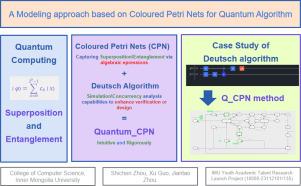基于彩色Petri网的量子算法建模方法
IF 4.1
2区 计算机科学
Q1 COMPUTER SCIENCE, SOFTWARE ENGINEERING
引用次数: 0
摘要
验证量子算法的正确性和降低理解阈值是量子计算的重要组成部分。正式方法作为一种有效的技术,正日益受到重视。考虑到量子算法的叠加性和纠缠性,合理和直观地形式化它们是一个很大的挑战。在我们的工作中,彩色Petri网(CPN)是Petri网的一个复杂的扩展,用于表示希尔伯特空间中的量子态,本文提出了基于CPN的量子算法的形式化方法。然后,利用Deutsch算法建模演示了构建CPN量子模型的过程,并在模型内对算法进行了仿真,记录了中间量子态,并对仿真结果进行了分析。Deutsch算法的量子特性如量子态之间的叠加和纠缠可以被合理地形式化,证明了本文模型的合理性和有效性。最后,通过构建一个简单的电路,验证了该模型对纠缠量子比特复值运算的建模能力。本文章由计算机程序翻译,如有差异,请以英文原文为准。

A Modeling approach based on Coloured Petri Nets for Quantum algorithm
Verifying the correctness of quantum algorithms and reducing the understanding threshold are important parts of quantum computing. Formal methods, as effective techniques, are increasingly being focused on for these purpose. Given the superposition and entanglement of quantum algorithms, reasonably and intuitively formalizing them is a big challenge. In our work, Coloured Petri Nets (CPN), a sophisticated extension of Petri nets, are harnessed to represent the quantum states in the Hilbert space, the formal approach based on CPN for quantum algorithms is proposed in this paper. Then, the process of constructing a CPN quantum model is demonstrated using the modeling of the Deutsch algorithm, simulations of the algorithm are conducted within the model, with intermediate quantum states being recorded, and the simulation results subsequently analyzed. The quantum properties of Deutsch algorithm such as superposition and entanglement among quantum states can be formalized reasonably, demonstrating the rationality and effectiveness of the model in this paper. Finally, this paper verifies the model’s capability in modeling complex-valued operations of entangled qubits through the construction of a simple circuit.
求助全文
通过发布文献求助,成功后即可免费获取论文全文。
去求助
来源期刊

Journal of Systems and Software
工程技术-计算机:理论方法
CiteScore
8.60
自引率
5.70%
发文量
193
审稿时长
16 weeks
期刊介绍:
The Journal of Systems and Software publishes papers covering all aspects of software engineering and related hardware-software-systems issues. All articles should include a validation of the idea presented, e.g. through case studies, experiments, or systematic comparisons with other approaches already in practice. Topics of interest include, but are not limited to:
•Methods and tools for, and empirical studies on, software requirements, design, architecture, verification and validation, maintenance and evolution
•Agile, model-driven, service-oriented, open source and global software development
•Approaches for mobile, multiprocessing, real-time, distributed, cloud-based, dependable and virtualized systems
•Human factors and management concerns of software development
•Data management and big data issues of software systems
•Metrics and evaluation, data mining of software development resources
•Business and economic aspects of software development processes
The journal welcomes state-of-the-art surveys and reports of practical experience for all of these topics.
 求助内容:
求助内容: 应助结果提醒方式:
应助结果提醒方式:


